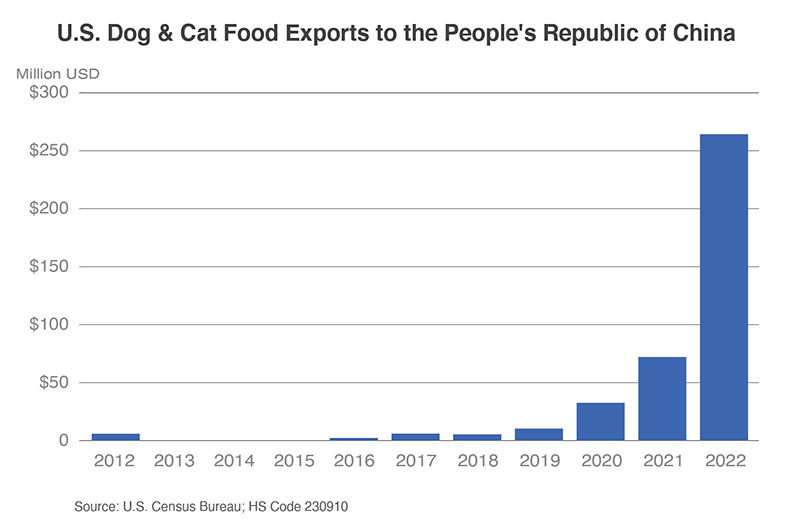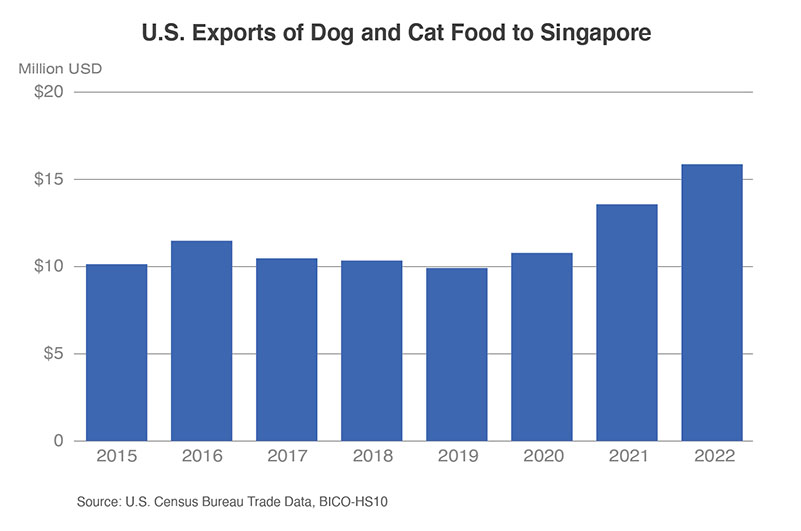WASHINGTON — On July 18 and 19, the US Department of Agriculture’s (USDA) Foreign Agricultural Service (FAS), detailed two countries showing significant promise for US pet food processors seeking to export their products: China and Singapore.
The world’s fastest growing pet food importer
According to the FAS, US dog and cat food exports to China hit a new record of $264 million in 2022, making China the second-largest export market for the United States, just second to Canada. The cause of this? A rising pet population.
 Source: US Census Bureau; HS Code 230910
Source: US Census Bureau; HS Code 230910
The country’s dog and cat population rose from 69 million in 2021 to 186 million in 2022, according to Euromonitor International. During the same period, China’s total dog and cat food imports increased from $10 million to $672 million, making it the world’s fastest-growing importer, according to the FAS.
The United States has made itself China’s top dog food and cat food supplier in just two years, according to the FAS. Additionally, US exports to China have already reached $139 million from January 2023 to May 2023 — that’s more than double compared to the same period in 2022.
Read more about exporting to China.
Potential for increased market share
According to the FAS, Singapore imports more than 90% of its food products and has a very diverse variety of trading partners. The United States exported about $1.4 billion of agricultural products to the country in 2022, making it Singapore’s third-largest agricultural exporter behind Malaysia and the European Union.
The country’s GDP in 2022 was $91,100 USD with a population of 5.7 million, according to the International Monetary Fund. With such high-income, consumers in Singapore are considered tech-savvy. According to Euromonitor, 94% of the population used the internet and nearly half (42%) used it to buy and sell goods in 2022. Additionally, in 2022, 59% of businesses in Singapore used the internet to place and receive orders. Such a tech-savvy population has also led to the growth of e-commerce in the country, with grocery e-commerce sales increasing 30% between 2017 and 2022.
All this has led to steady growth for imports of dog and cat food products. During the pandemic, pet ownership throughout Singapore steadily rose, but has recently begun to slow. Despite this, pet owners in the country have embraced the humanization of pets, treating their companions as members of their family and demanding healthy and innovative pet nutrition products.
According to the FAS, the country imported $69.2 million worth of dog and cat food products from all over the world in 2022, a steady increase from $43.7 million in 2018.
Pet food competition is fierce in Singapore. According to Euromonitor, there are more than 20 dog food companies in the country, and none of these companies hold more than 8% of pet food sales. Additionally, the cat food market is believed to be even more concentrated. Despite this, the United States exported $15.9 million in dog and cat food in 2022, up 17% from 2021. The United States currently holds a 23% market share in Singapore’s pet food market, just second to Thailand.
 Source: US Census Bureau Trade Data, BICO-HS10
Source: US Census Bureau Trade Data, BICO-HS10
The retail value of cat food sales in Singapore is set to increase 7% in 2023 with e-commerce serving an imperative role in retail distribution. The retail value of dog food sales is expected to increase 6% in 2023 with consumers specifically interested in premium and innovative pet food products.
Find more articles related to pet food export opportunities and trade.



